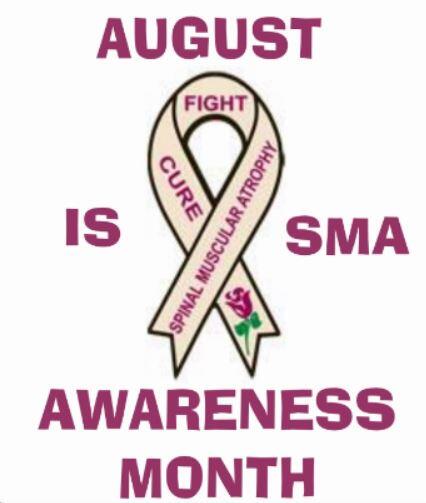
Tag Archives: August
August is SMA Awareness Month
August is SMA Awareness month and families and friends around the country are joining together to help increase awareness—not only of SMA, but also of our hope for a treatment and cure.
What is Spinal Muscular Atrophy?
Spinal Muscular Atrophy (SMA) Types I, II, and III belong to a group of hereditary diseases that cause weakness and wasting of the voluntary muscles in the arms and legs of infants and children. The disorders are caused by an abnormal or missing gene known as the survival motor neuron gene 1 (SMN1), which is responsible for the production of a protein essential to motor neurons. Without this protein, lower motor neurons in the spinal cord degenerate and die. The type of SMA (I, II, or III) is determined by the age of onset and the severity of symptoms. Type I (also known as Werdnig-Hoffman disease, or infantile-onset SMA) is evident at birth or within the first few months. Symptoms include floppy limbs and trunk, feeble movements of the arms and legs, swallowing and feeding difficulties, and impaired breathing. Type II (the intermediate form) usually begins 6 and 18 months of age. Legs tend to be more impaired than arms. Children with Type II may able to sit and some may be able to stand or walk with help. Symptoms of Type III (also called Kugelberg-Welander disease) appear between 2 and 17 years of age and include difficulty running, climbing steps, or rising from a chair. The lower extremities are most often affected. Complications include scoliosis and chronic shortening of muscles or tendons around joints.
Is there any treatment?
There is no cure for SMA. Treatment consists of managing the symptoms and preventing complications.
What is the prognosis?
The prognosis is poor for babies with SMA Type I. Most die within the first two years. For children with SMA Type II, the prognosis for life expectancy or for independent standing or walking roughly correlates with how old they are when they first begin to experience symptoms – older children tend to have less severe symptoms Life expectancy is reduced but some individuals live into adolescence or young adulthood. Individuals with SMA type III may be prone to respiratory infections but with care may have a normal lifespan.
What research is being done?
Between 2003 and 2012, the NINDS piloted the Spinal Muscular Atrophy Project to expedite therapeutics development for this hereditary neurodegenerative disease. The Project was designed to accelerate the research process by identifying drugs that increase the level of SMN protein in cultured cells, so that they could be used as potential leads for further drug discovery and clinical testing. Read more about the history of this pioneering effort and how it led to collaboration with several pharmaceutical and biotechnology companies.
2015 National Veterans Golden Age Games

Today is the Freedom Fest at Fort Kent, Maine

Freedom Fest 2014 is an outdoor concert on August 09, 2014 in Fort Kent, Maine to raise funds for a
Veterans Museum & Community Center in Northern Maine.
A joint project of Martin-Klein American Legion Post 133 and the Fort Kent Historical Society
“So that the future can understand what the past has given in the name of Freedom”
Their Vision
To build a Veterans Museum & community center in Northern Maine to showcase and appreciate the sacrifices provided on our behalf so that our children and future generations will understand the true cost of freedom. The Center shall be a living, breathing kiosk of history providing a dynamic educational opportunity for all those in the community!
Fort Kent Municipal Airport
Tickets: FreedomFest2014.bpt.me
ADULT: $40/$35 advance purchase
Under 16: $25 Under 12: FREE
or visit Albert’s Jewelry or Gas-n-Go Foods in Fort Kent
Bring your own chair or blankets
NO Backpacks
NO Coolers
Contact Information
Duane Belanger – Martin-Klein American Legion
Email: commander@americanlegionpost133.org
Chad Pelletier – President of Fort Kent Historical Society
Email: fkhistory1@yahoo.com
Featuring
Thomas Nicholas Band
Madison Rising
Mallett Brothers Band
Spirit of Cash
Harold Ford
Laura Lucy & the Cash Band
Gunther Brown
Forget, Forget
Randolph S Michaud
Tennessee Haze
Uprooted
Kindered
Along with the cast of Freedom Fighters TV!
Featuring on opening Bike Run from Plourde Harley Davidson , Caribou to Fort Kent lead by the Patriot Guard Riders & First Lady Ann LePage honoring the fallen and respectfully welcomed in Fort Kent by the Saluting Marine SSG Tim Chambers! Honored to welcome quad-amputee and American Hero SSG Travis MIlls as well!
Vendors – Partners
VMI New England ● Fort Kent Lions ● Vets Rock ● Young Marines ● Toys For Tots ● Post 133 LadiesAuxiliary ● Fort Kent Knights of Columbus ● Market Street Coop ● Armed Forces Motorsports Foundation ● Maine Veterans Homes ● National Veterans Family Center ● US VA Togus ● Maine Military & Community Network ● Gas-N-Go Foods ● Albert’s Jewelry ● Maine Veterans Services ● VetCenter ● Maine National Guard
● VFW Department of Maine ● American Legion Department of Maine ● AMVETS Department of Maine ● Fort Kent VFW ● Gary I Gordon Division Sea Cadets ● KTC’s Brainfreeze ● Mad Town Grillers ● Carter Dogs ● Wreaths Across America ● Jeni’s Jewelry ● JSB Arts ● Maine State Council Knights of Columbus ● the Lunchbox ● Sally Bateau ● Maine Army Guard 185th Engineer Company ● Honor & Remember – Massachusetts Chapter● Greater Fort Kent Area Chamber of Commerce

Make a Donation — http://www.iamtheamericanflag.com/donate/
Agust is SMA Awareness Month

August is SMA Awareness month and families and friends around the country are joining together to help increase awareness—not only of SMA, but also of our hope for a treatment and cure.
What is Spinal Muscular Atrophy?
Spinal Muscular Atrophy (SMA) Types I, II, and III belong to a group of hereditary diseases that cause weakness and wasting of the voluntary muscles in the arms and legs of infants and children. The disorders are caused by an abnormal or missing gene known as the survival motor neuron gene 1 (SMN1), which is responsible for the production of a protein essential to motor neurons. Without this protein, lower motor neurons in the spinal cord degenerate and die. The type of SMA (I, II, or III) is determined by the age of onset and the severity of symptoms. Type I (also known as Werdnig-Hoffman disease, or infantile-onset SMA) is evident at birth or within the first few months. Symptoms include floppy limbs and trunk, feeble movements of the arms and legs, swallowing and feeding difficulties, and impaired breathing. Type II (the intermediate form) usually begins 6 and 18 months of age. Legs tend to be more impaired than arms. Children with Type II may able to sit and some may be able to stand or walk with help. Symptoms of Type III (also called Kugelberg-Welander disease) appear between 2 and 17 years of age and include difficulty running, climbing steps, or rising from a chair. The lower extremities are most often affected. Complications include scoliosis and chronic shortening of muscles or tendons around joints.
Is there any treatment?
There is no cure for SMA. Treatment consists of managing the symptoms and preventing complications.
What is the prognosis?
The prognosis is poor for babies with SMA Type I. Most die within the first two years. For children with SMA Type II, the prognosis for life expectancy or for independent standing or walking roughly correlates with how old they are when they first begin to experience symptoms – older children tend to have less severe symptoms Life expectancy is reduced but some individuals live into adolescence or young adulthood. Individuals with SMA type III may be prone to respiratory infections but with care may have a normal lifespan.
What research is being done?
Between 2003 and 2012, the NINDS piloted the Spinal Muscular Atrophy Project to expedite therapeutics development for this hereditary neurodegenerative disease. The Project was designed to accelerate the research process by identifying drugs that increase the level of SMN protein in cultured cells, so that they could be used as potential leads for further drug discovery and clinical testing. Read more about the history of this pioneering effort and how it led to collaboration with several pharmaceutical and biotechnology companies.
